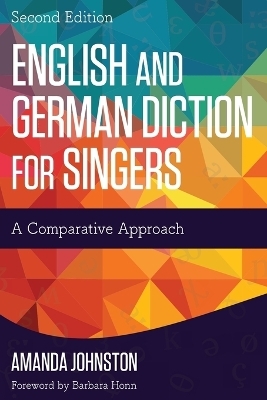
English and German Diction for Singers
Rowman & Littlefield (Verlag)
978-1-4422-6089-4 (ISBN)
Lyric diction is a portal to powerful and meaningful vocal performance because diction enables singers to communicate the vision of both the poet and the composer. The study of diction involves learning to perceive speech patterns in different languages, practicing their precise articulation, recognizing this in speech and singing, and developing an awareness of the refined movements of the articulators and their effects on singing tone.
In the second edition of English and German Diction for Singers, Amanda Johnston continues her comparative, modernized approach to lyric diction. This comprehensive resource offers a thorough analysis of the German and English languages and includes extensive oral drills, word lists, tables, charts, musical examples, and even tongue twisters. Unique to this publication is the illustration of the rhythmic timing and release of consonants within the International Phonetic Alphabet transcriptions in all musical examples.
This book is designed for both undergraduate and graduate courses in German and English lyric diction and is an invaluable resource for classical singers, vocal coaches, and voice teachers alike.
Improvements to the second edition include:
·An online workbook that includes extensive written exercises suitable for classroom or independent use
·Chapter-by-chapter video clips that demonstrate the concepts addressed in the text
·Expanded chapters address the schwa, the treatment of monosyllabic incidental words, the use of R, and the correct formation of the elusive upsilon and extended epsilon
·Consideration of loan words and stressed vs. unstressed closed German vowels
·Integrated practice drills for mastering challenging and unfamiliar phonemes
·Enlarged musical examples show the rhythmic timing and release of voiced and voiceless consonants
·An expanded appendix on suggested repertoire for diction study
·Inclusion of specific diction choices suitable for musical theatre repertoire
·Expanded discussion of healthy glottal onsets, including the concept of juncture
·Use of the latest resources, namely Deutsche Rechtschreibung (2014) and Cambridge Pronouncing Dictionary, 18th edition (2011)
·For all users, there is a WORKBOOK. Access the workbook here.
·The ANSWER KEY is available for instructors. Contact textbooks@rowman.com for details.
Amanda Johnston is a collaborative pianist and vocal coach. She is associate professor of music at the University of Mississippi, Oxford. She is also on faculty at Musiktheater Bavaria. For further information, visit her website: www.amandajohnston.ca.
PART I: INTRODUCTION
Chapter 1: Elementary Concepts
Chapter 2: Proficiency in English IPA
Chapter 3: Proficiency in German IPA
PART II: ENGLISH
Chapter 4: Introduction to English Diction for Singers
Chapter 5: English Phonemes
Chapter 6: The Structure of English
Chapter 7: Characteristic English Phonemes
Chapter 8: Vowels
Chapter 9: Glides and Approximants
Chapter 10: Consonants
Chapter 11: Advanced Concepts in Diction
Chapter 12: Common Pitfalls
PART III: GERMAN
Chapter 13: Introduction to German Diction for Singers
Chapter 14: German Phonemes
Chapter 15: The Structure of German
Chapter 16: Characteristic German Phonemes
Chapter 17: Vowels
Chapter 18: Consonants
Chapter 19: Advanced Concepts in Diction
Chapter 20: Common Pitfalls
PART IV: ENGLISH AND GERMAN—COMMON GROUND
Chapter 21: Commonalities Between English and German
Chapter 22: Legato Singing
Chapter 23: Close but No Cigar
Chapter 24: Lyric Diction in Opera
Chapter 25: Concise History of the English Language
Appendix A: Glossary of Phonetic and Anatomical Terms
Appendix B: Supplements
Appendix C: Suggested Repertoire for Lyric Diction Study
Flashcard (removable reference for English and German IPA)
| Erscheinungsdatum | 13.08.2016 |
|---|---|
| Verlagsort | Lanham, MD |
| Sprache | englisch |
| Maße | 158 x 223 mm |
| Gewicht | 544 g |
| Themenwelt | Kunst / Musik / Theater ► Musik ► Klassik / Oper / Musical |
| ISBN-10 | 1-4422-6089-0 / 1442260890 |
| ISBN-13 | 978-1-4422-6089-4 / 9781442260894 |
| Zustand | Neuware |
| Haben Sie eine Frage zum Produkt? |
aus dem Bereich


